Bentonite Added Rice Husk as Impervious Barriers of Landfill Covers
VerifiedAdded on 2023/06/05
|12
|2462
|378
AI Summary
This study explores the use of bentonite added rice husk as impervious barriers for landfill covers. It discusses the properties of rice husks ashes, burning process of rice husks, and the various applications of rice husk ash in the construction industry. The study concludes that the addition of bentonite added rice husks greatly contributes to the improvement of soil strength and reduces soil permeability, making it ideal for landfill covers.
Contribute Materials
Your contribution can guide someone’s learning journey. Share your
documents today.
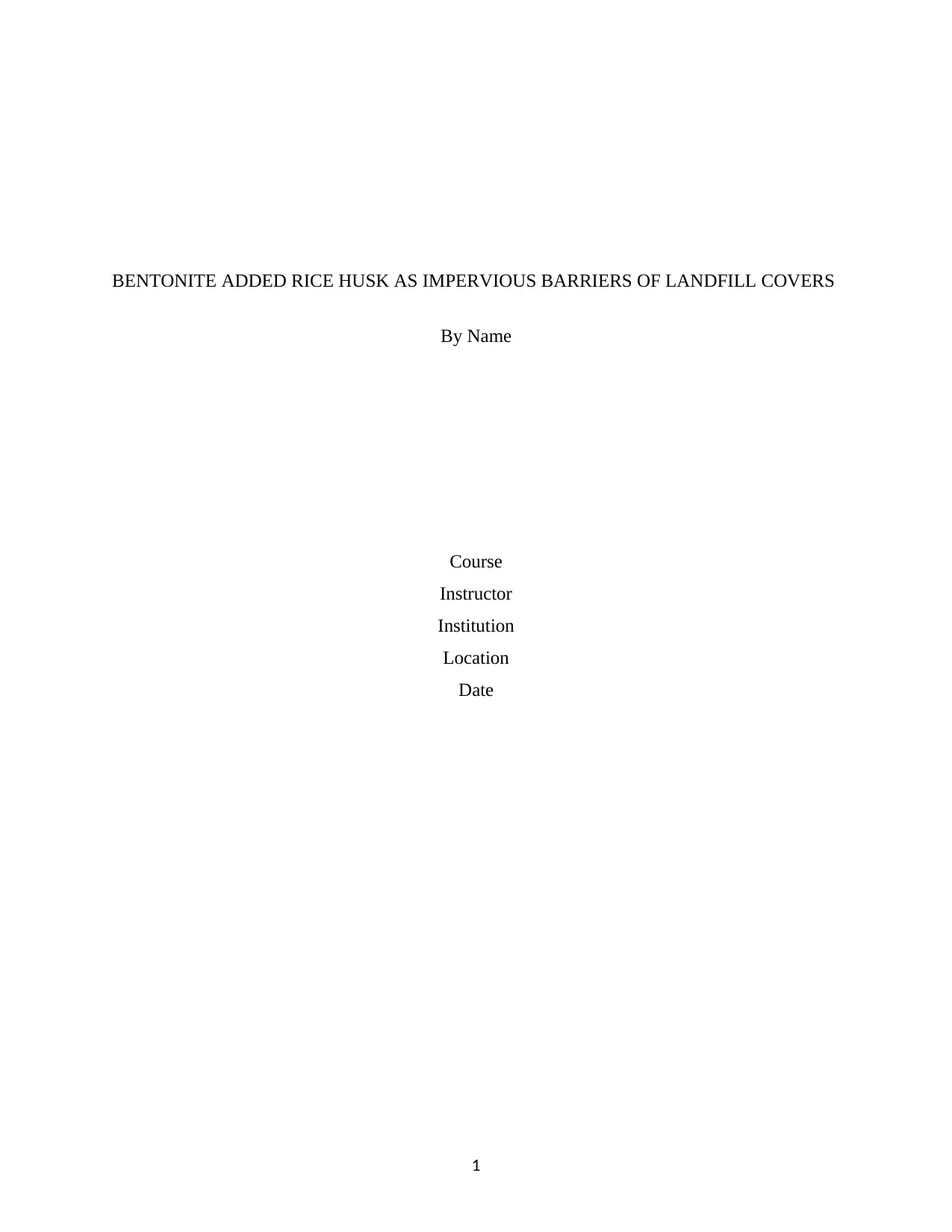
BENTONITE ADDED RICE HUSK AS IMPERVIOUS BARRIERS OF LANDFILL COVERS
By Name
Course
Instructor
Institution
Location
Date
1
By Name
Course
Instructor
Institution
Location
Date
1
Secure Best Marks with AI Grader
Need help grading? Try our AI Grader for instant feedback on your assignments.
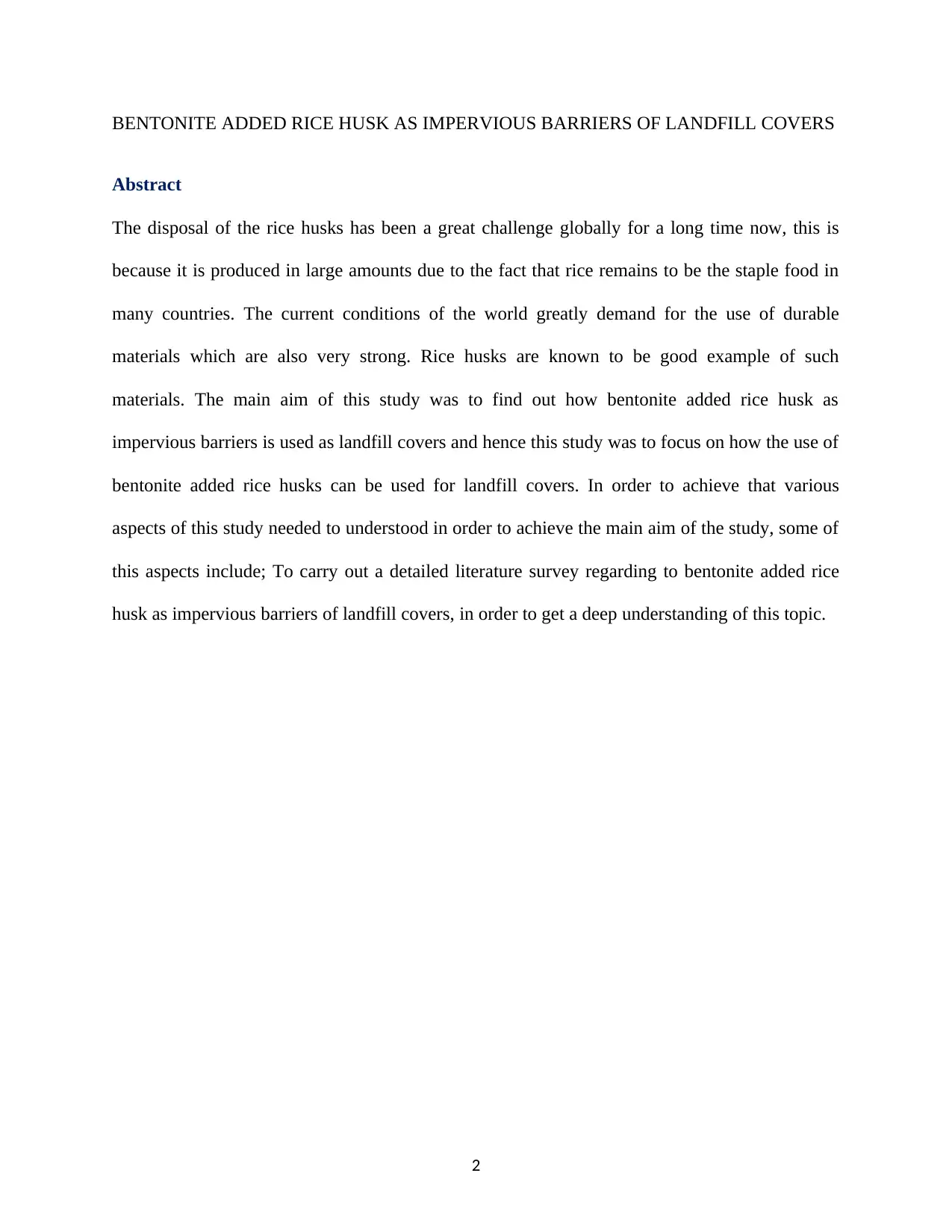
BENTONITE ADDED RICE HUSK AS IMPERVIOUS BARRIERS OF LANDFILL COVERS
Abstract
The disposal of the rice husks has been a great challenge globally for a long time now, this is
because it is produced in large amounts due to the fact that rice remains to be the staple food in
many countries. The current conditions of the world greatly demand for the use of durable
materials which are also very strong. Rice husks are known to be good example of such
materials. The main aim of this study was to find out how bentonite added rice husk as
impervious barriers is used as landfill covers and hence this study was to focus on how the use of
bentonite added rice husks can be used for landfill covers. In order to achieve that various
aspects of this study needed to understood in order to achieve the main aim of the study, some of
this aspects include; To carry out a detailed literature survey regarding to bentonite added rice
husk as impervious barriers of landfill covers, in order to get a deep understanding of this topic.
2
Abstract
The disposal of the rice husks has been a great challenge globally for a long time now, this is
because it is produced in large amounts due to the fact that rice remains to be the staple food in
many countries. The current conditions of the world greatly demand for the use of durable
materials which are also very strong. Rice husks are known to be good example of such
materials. The main aim of this study was to find out how bentonite added rice husk as
impervious barriers is used as landfill covers and hence this study was to focus on how the use of
bentonite added rice husks can be used for landfill covers. In order to achieve that various
aspects of this study needed to understood in order to achieve the main aim of the study, some of
this aspects include; To carry out a detailed literature survey regarding to bentonite added rice
husk as impervious barriers of landfill covers, in order to get a deep understanding of this topic.
2
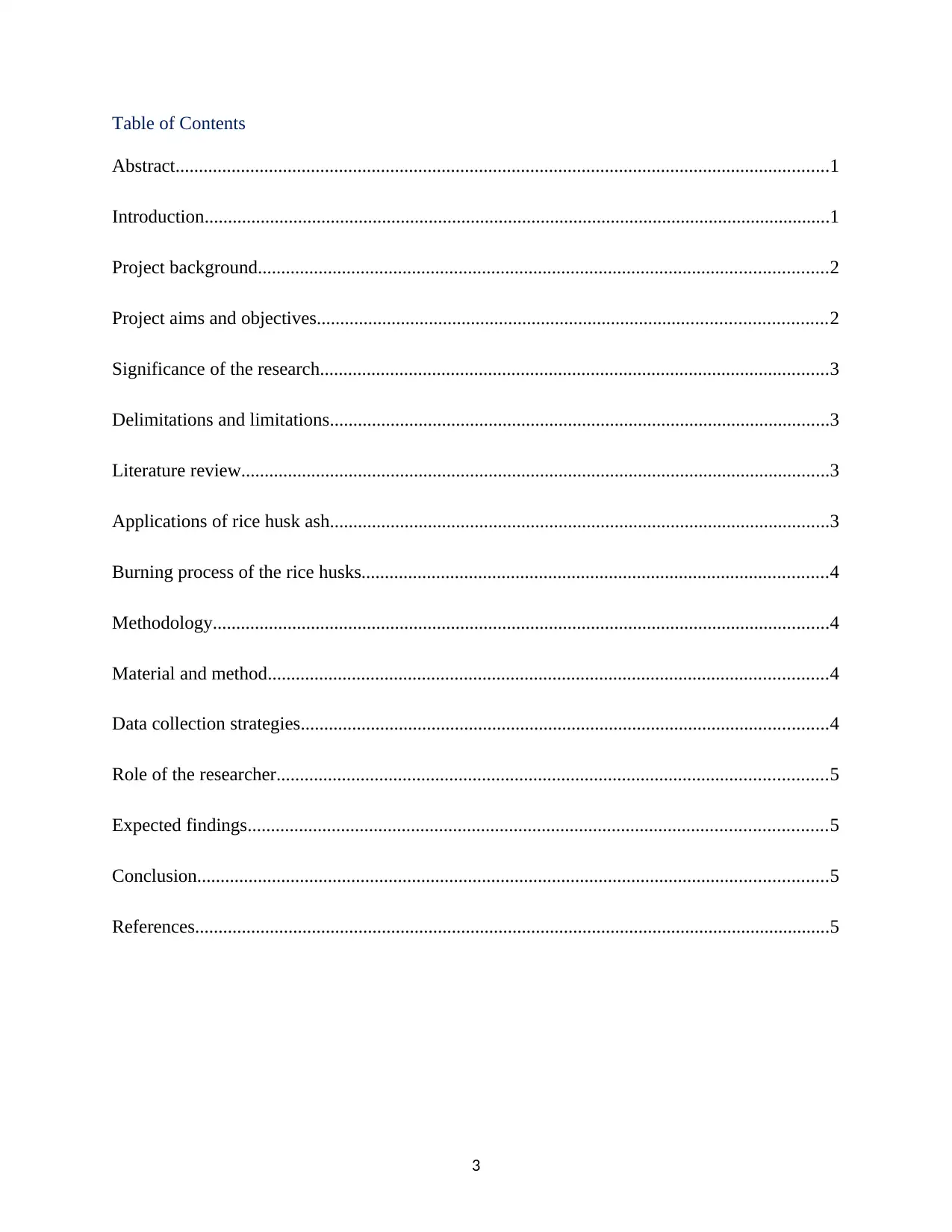
Table of Contents
Abstract............................................................................................................................................1
Introduction......................................................................................................................................1
Project background..........................................................................................................................2
Project aims and objectives.............................................................................................................2
Significance of the research.............................................................................................................3
Delimitations and limitations...........................................................................................................3
Literature review..............................................................................................................................3
Applications of rice husk ash...........................................................................................................3
Burning process of the rice husks....................................................................................................4
Methodology....................................................................................................................................4
Material and method........................................................................................................................4
Data collection strategies.................................................................................................................4
Role of the researcher......................................................................................................................5
Expected findings............................................................................................................................5
Conclusion.......................................................................................................................................5
References........................................................................................................................................5
3
Abstract............................................................................................................................................1
Introduction......................................................................................................................................1
Project background..........................................................................................................................2
Project aims and objectives.............................................................................................................2
Significance of the research.............................................................................................................3
Delimitations and limitations...........................................................................................................3
Literature review..............................................................................................................................3
Applications of rice husk ash...........................................................................................................3
Burning process of the rice husks....................................................................................................4
Methodology....................................................................................................................................4
Material and method........................................................................................................................4
Data collection strategies.................................................................................................................4
Role of the researcher......................................................................................................................5
Expected findings............................................................................................................................5
Conclusion.......................................................................................................................................5
References........................................................................................................................................5
3

4
Secure Best Marks with AI Grader
Need help grading? Try our AI Grader for instant feedback on your assignments.
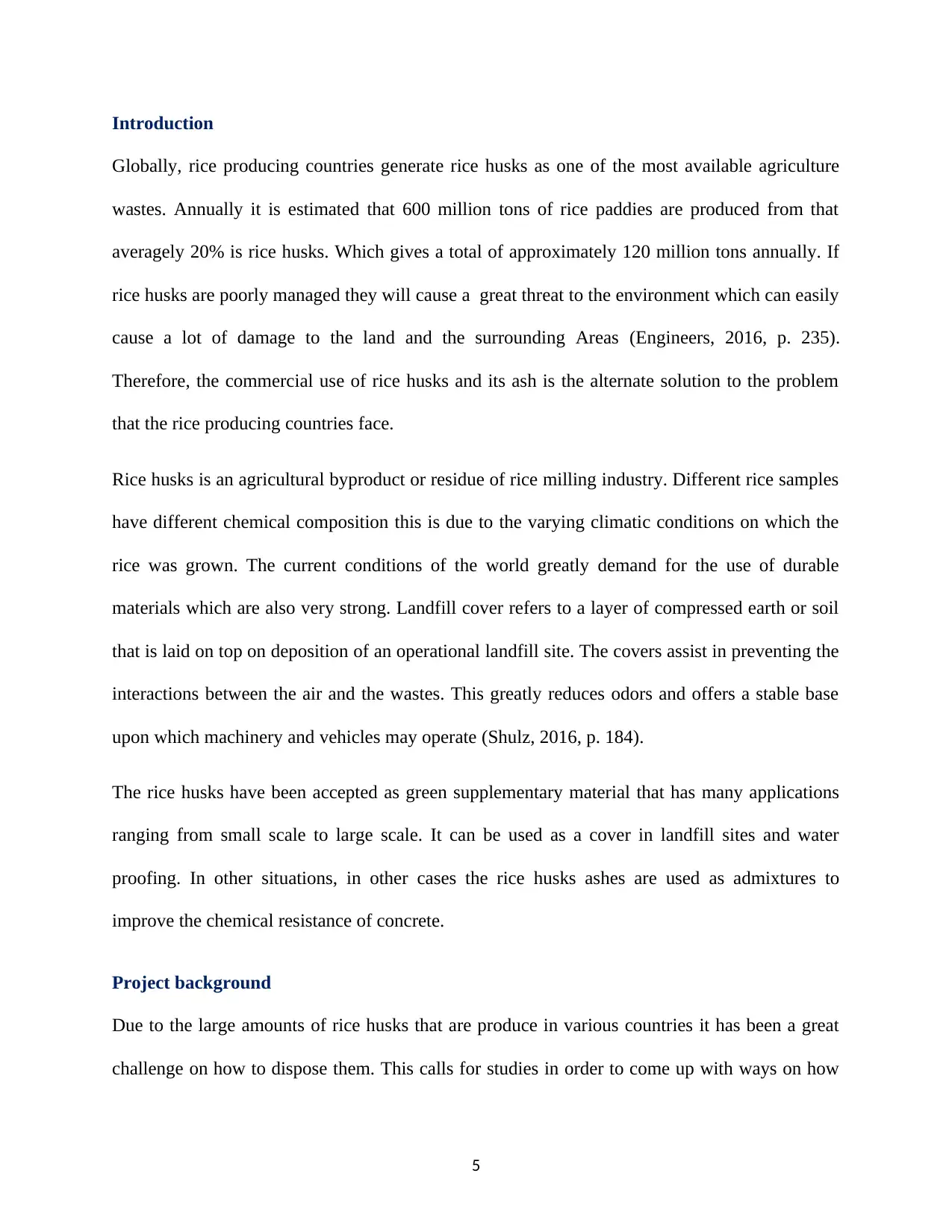
Introduction
Globally, rice producing countries generate rice husks as one of the most available agriculture
wastes. Annually it is estimated that 600 million tons of rice paddies are produced from that
averagely 20% is rice husks. Which gives a total of approximately 120 million tons annually. If
rice husks are poorly managed they will cause a great threat to the environment which can easily
cause a lot of damage to the land and the surrounding Areas (Engineers, 2016, p. 235).
Therefore, the commercial use of rice husks and its ash is the alternate solution to the problem
that the rice producing countries face.
Rice husks is an agricultural byproduct or residue of rice milling industry. Different rice samples
have different chemical composition this is due to the varying climatic conditions on which the
rice was grown. The current conditions of the world greatly demand for the use of durable
materials which are also very strong. Landfill cover refers to a layer of compressed earth or soil
that is laid on top on deposition of an operational landfill site. The covers assist in preventing the
interactions between the air and the wastes. This greatly reduces odors and offers a stable base
upon which machinery and vehicles may operate (Shulz, 2016, p. 184).
The rice husks have been accepted as green supplementary material that has many applications
ranging from small scale to large scale. It can be used as a cover in landfill sites and water
proofing. In other situations, in other cases the rice husks ashes are used as admixtures to
improve the chemical resistance of concrete.
Project background
Due to the large amounts of rice husks that are produce in various countries it has been a great
challenge on how to dispose them. This calls for studies in order to come up with ways on how
5
Globally, rice producing countries generate rice husks as one of the most available agriculture
wastes. Annually it is estimated that 600 million tons of rice paddies are produced from that
averagely 20% is rice husks. Which gives a total of approximately 120 million tons annually. If
rice husks are poorly managed they will cause a great threat to the environment which can easily
cause a lot of damage to the land and the surrounding Areas (Engineers, 2016, p. 235).
Therefore, the commercial use of rice husks and its ash is the alternate solution to the problem
that the rice producing countries face.
Rice husks is an agricultural byproduct or residue of rice milling industry. Different rice samples
have different chemical composition this is due to the varying climatic conditions on which the
rice was grown. The current conditions of the world greatly demand for the use of durable
materials which are also very strong. Landfill cover refers to a layer of compressed earth or soil
that is laid on top on deposition of an operational landfill site. The covers assist in preventing the
interactions between the air and the wastes. This greatly reduces odors and offers a stable base
upon which machinery and vehicles may operate (Shulz, 2016, p. 184).
The rice husks have been accepted as green supplementary material that has many applications
ranging from small scale to large scale. It can be used as a cover in landfill sites and water
proofing. In other situations, in other cases the rice husks ashes are used as admixtures to
improve the chemical resistance of concrete.
Project background
Due to the large amounts of rice husks that are produce in various countries it has been a great
challenge on how to dispose them. This calls for studies in order to come up with ways on how
5
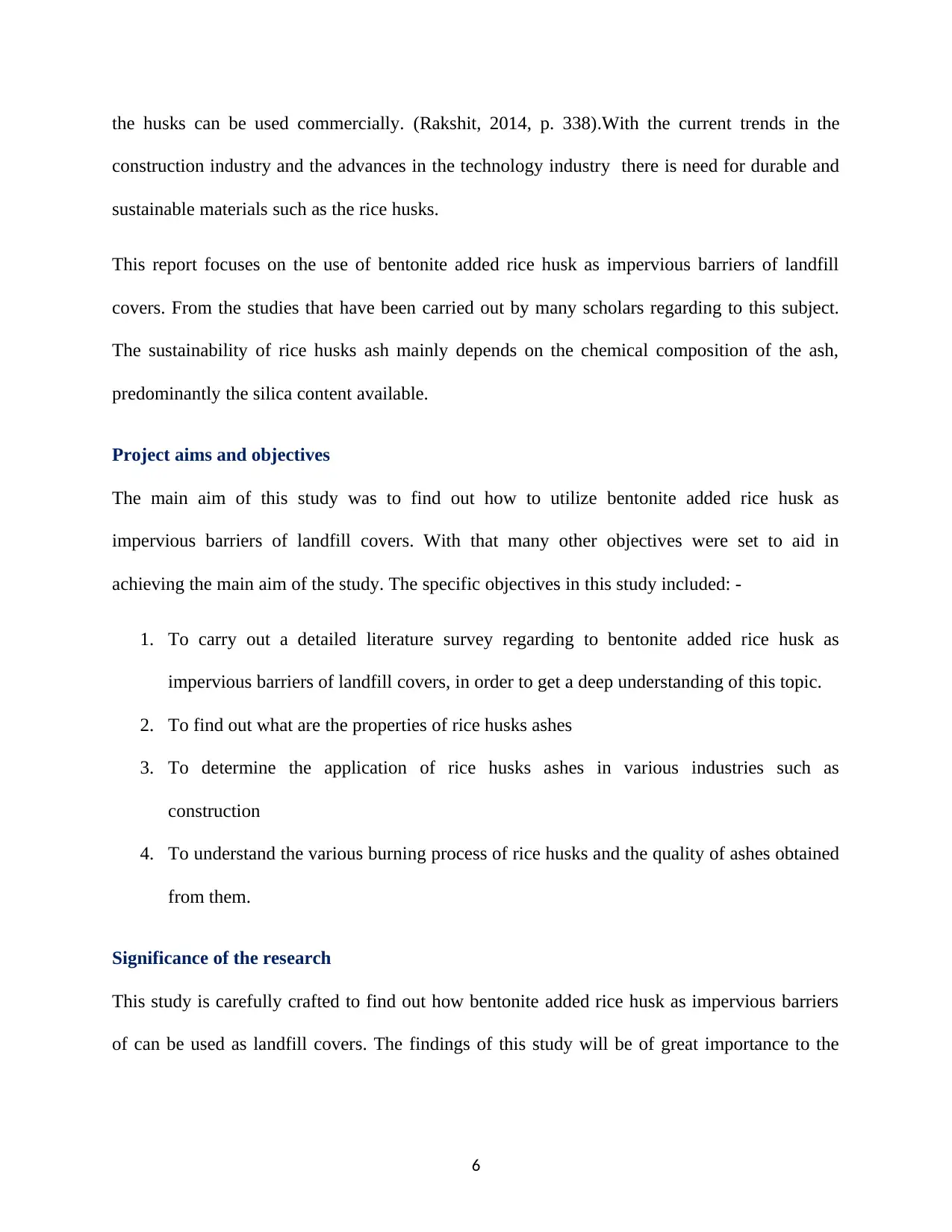
the husks can be used commercially. (Rakshit, 2014, p. 338).With the current trends in the
construction industry and the advances in the technology industry there is need for durable and
sustainable materials such as the rice husks.
This report focuses on the use of bentonite added rice husk as impervious barriers of landfill
covers. From the studies that have been carried out by many scholars regarding to this subject.
The sustainability of rice husks ash mainly depends on the chemical composition of the ash,
predominantly the silica content available.
Project aims and objectives
The main aim of this study was to find out how to utilize bentonite added rice husk as
impervious barriers of landfill covers. With that many other objectives were set to aid in
achieving the main aim of the study. The specific objectives in this study included: -
1. To carry out a detailed literature survey regarding to bentonite added rice husk as
impervious barriers of landfill covers, in order to get a deep understanding of this topic.
2. To find out what are the properties of rice husks ashes
3. To determine the application of rice husks ashes in various industries such as
construction
4. To understand the various burning process of rice husks and the quality of ashes obtained
from them.
Significance of the research
This study is carefully crafted to find out how bentonite added rice husk as impervious barriers
of can be used as landfill covers. The findings of this study will be of great importance to the
6
construction industry and the advances in the technology industry there is need for durable and
sustainable materials such as the rice husks.
This report focuses on the use of bentonite added rice husk as impervious barriers of landfill
covers. From the studies that have been carried out by many scholars regarding to this subject.
The sustainability of rice husks ash mainly depends on the chemical composition of the ash,
predominantly the silica content available.
Project aims and objectives
The main aim of this study was to find out how to utilize bentonite added rice husk as
impervious barriers of landfill covers. With that many other objectives were set to aid in
achieving the main aim of the study. The specific objectives in this study included: -
1. To carry out a detailed literature survey regarding to bentonite added rice husk as
impervious barriers of landfill covers, in order to get a deep understanding of this topic.
2. To find out what are the properties of rice husks ashes
3. To determine the application of rice husks ashes in various industries such as
construction
4. To understand the various burning process of rice husks and the quality of ashes obtained
from them.
Significance of the research
This study is carefully crafted to find out how bentonite added rice husk as impervious barriers
of can be used as landfill covers. The findings of this study will be of great importance to the
6
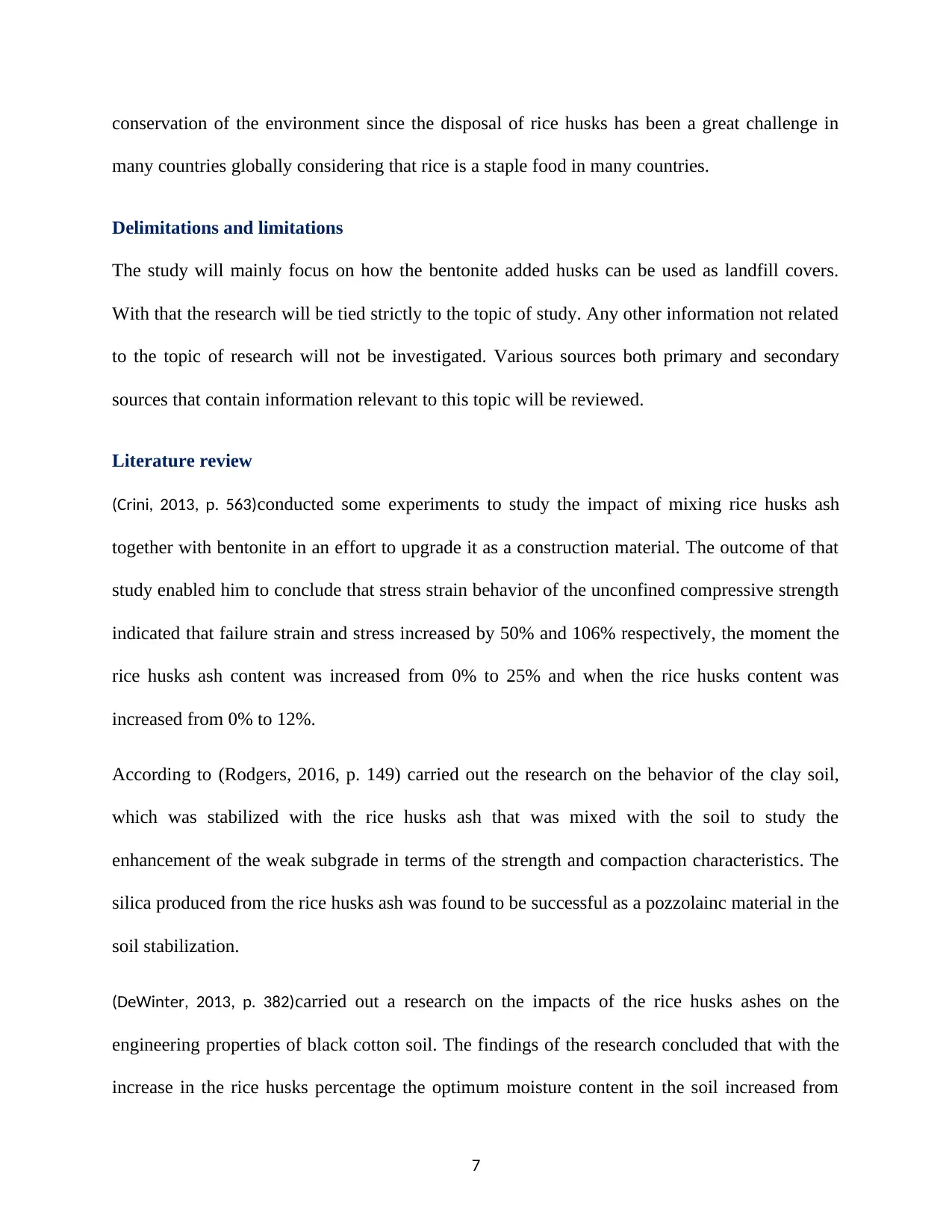
conservation of the environment since the disposal of rice husks has been a great challenge in
many countries globally considering that rice is a staple food in many countries.
Delimitations and limitations
The study will mainly focus on how the bentonite added husks can be used as landfill covers.
With that the research will be tied strictly to the topic of study. Any other information not related
to the topic of research will not be investigated. Various sources both primary and secondary
sources that contain information relevant to this topic will be reviewed.
Literature review
(Crini, 2013, p. 563)conducted some experiments to study the impact of mixing rice husks ash
together with bentonite in an effort to upgrade it as a construction material. The outcome of that
study enabled him to conclude that stress strain behavior of the unconfined compressive strength
indicated that failure strain and stress increased by 50% and 106% respectively, the moment the
rice husks ash content was increased from 0% to 25% and when the rice husks content was
increased from 0% to 12%.
According to (Rodgers, 2016, p. 149) carried out the research on the behavior of the clay soil,
which was stabilized with the rice husks ash that was mixed with the soil to study the
enhancement of the weak subgrade in terms of the strength and compaction characteristics. The
silica produced from the rice husks ash was found to be successful as a pozzolainc material in the
soil stabilization.
(DeWinter, 2013, p. 382)carried out a research on the impacts of the rice husks ashes on the
engineering properties of black cotton soil. The findings of the research concluded that with the
increase in the rice husks percentage the optimum moisture content in the soil increased from
7
many countries globally considering that rice is a staple food in many countries.
Delimitations and limitations
The study will mainly focus on how the bentonite added husks can be used as landfill covers.
With that the research will be tied strictly to the topic of study. Any other information not related
to the topic of research will not be investigated. Various sources both primary and secondary
sources that contain information relevant to this topic will be reviewed.
Literature review
(Crini, 2013, p. 563)conducted some experiments to study the impact of mixing rice husks ash
together with bentonite in an effort to upgrade it as a construction material. The outcome of that
study enabled him to conclude that stress strain behavior of the unconfined compressive strength
indicated that failure strain and stress increased by 50% and 106% respectively, the moment the
rice husks ash content was increased from 0% to 25% and when the rice husks content was
increased from 0% to 12%.
According to (Rodgers, 2016, p. 149) carried out the research on the behavior of the clay soil,
which was stabilized with the rice husks ash that was mixed with the soil to study the
enhancement of the weak subgrade in terms of the strength and compaction characteristics. The
silica produced from the rice husks ash was found to be successful as a pozzolainc material in the
soil stabilization.
(DeWinter, 2013, p. 382)carried out a research on the impacts of the rice husks ashes on the
engineering properties of black cotton soil. The findings of the research concluded that with the
increase in the rice husks percentage the optimum moisture content in the soil increased from
7
Paraphrase This Document
Need a fresh take? Get an instant paraphrase of this document with our AI Paraphraser
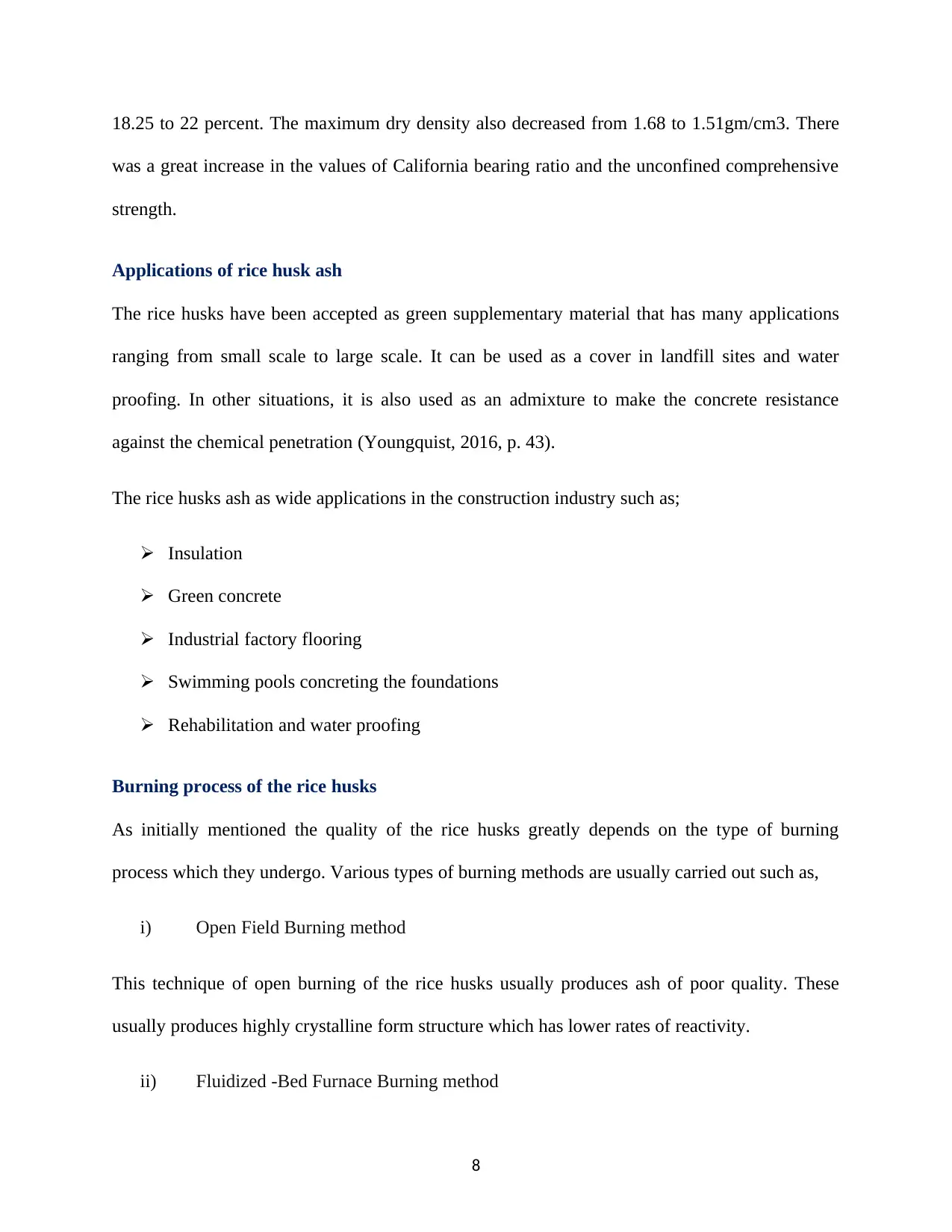
18.25 to 22 percent. The maximum dry density also decreased from 1.68 to 1.51gm/cm3. There
was a great increase in the values of California bearing ratio and the unconfined comprehensive
strength.
Applications of rice husk ash
The rice husks have been accepted as green supplementary material that has many applications
ranging from small scale to large scale. It can be used as a cover in landfill sites and water
proofing. In other situations, it is also used as an admixture to make the concrete resistance
against the chemical penetration (Youngquist, 2016, p. 43).
The rice husks ash as wide applications in the construction industry such as;
Insulation
Green concrete
Industrial factory flooring
Swimming pools concreting the foundations
Rehabilitation and water proofing
Burning process of the rice husks
As initially mentioned the quality of the rice husks greatly depends on the type of burning
process which they undergo. Various types of burning methods are usually carried out such as,
i) Open Field Burning method
This technique of open burning of the rice husks usually produces ash of poor quality. These
usually produces highly crystalline form structure which has lower rates of reactivity.
ii) Fluidized -Bed Furnace Burning method
8
was a great increase in the values of California bearing ratio and the unconfined comprehensive
strength.
Applications of rice husk ash
The rice husks have been accepted as green supplementary material that has many applications
ranging from small scale to large scale. It can be used as a cover in landfill sites and water
proofing. In other situations, it is also used as an admixture to make the concrete resistance
against the chemical penetration (Youngquist, 2016, p. 43).
The rice husks ash as wide applications in the construction industry such as;
Insulation
Green concrete
Industrial factory flooring
Swimming pools concreting the foundations
Rehabilitation and water proofing
Burning process of the rice husks
As initially mentioned the quality of the rice husks greatly depends on the type of burning
process which they undergo. Various types of burning methods are usually carried out such as,
i) Open Field Burning method
This technique of open burning of the rice husks usually produces ash of poor quality. These
usually produces highly crystalline form structure which has lower rates of reactivity.
ii) Fluidized -Bed Furnace Burning method
8
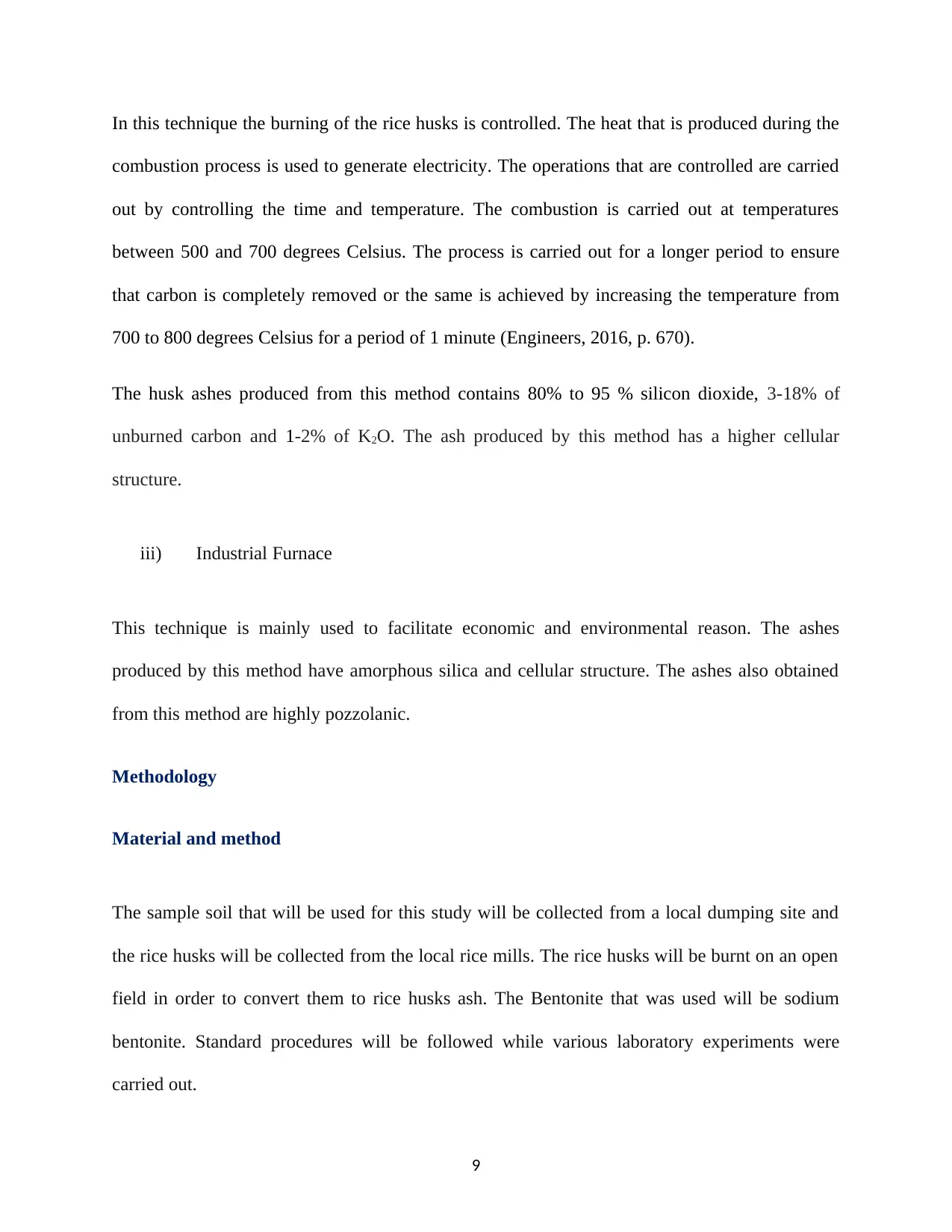
In this technique the burning of the rice husks is controlled. The heat that is produced during the
combustion process is used to generate electricity. The operations that are controlled are carried
out by controlling the time and temperature. The combustion is carried out at temperatures
between 500 and 700 degrees Celsius. The process is carried out for a longer period to ensure
that carbon is completely removed or the same is achieved by increasing the temperature from
700 to 800 degrees Celsius for a period of 1 minute (Engineers, 2016, p. 670).
The husk ashes produced from this method contains 80% to 95 % silicon dioxide, 3-18% of
unburned carbon and 1-2% of K2O. The ash produced by this method has a higher cellular
structure.
iii) Industrial Furnace
This technique is mainly used to facilitate economic and environmental reason. The ashes
produced by this method have amorphous silica and cellular structure. The ashes also obtained
from this method are highly pozzolanic.
Methodology
Material and method
The sample soil that will be used for this study will be collected from a local dumping site and
the rice husks will be collected from the local rice mills. The rice husks will be burnt on an open
field in order to convert them to rice husks ash. The Bentonite that was used will be sodium
bentonite. Standard procedures will be followed while various laboratory experiments were
carried out.
9
combustion process is used to generate electricity. The operations that are controlled are carried
out by controlling the time and temperature. The combustion is carried out at temperatures
between 500 and 700 degrees Celsius. The process is carried out for a longer period to ensure
that carbon is completely removed or the same is achieved by increasing the temperature from
700 to 800 degrees Celsius for a period of 1 minute (Engineers, 2016, p. 670).
The husk ashes produced from this method contains 80% to 95 % silicon dioxide, 3-18% of
unburned carbon and 1-2% of K2O. The ash produced by this method has a higher cellular
structure.
iii) Industrial Furnace
This technique is mainly used to facilitate economic and environmental reason. The ashes
produced by this method have amorphous silica and cellular structure. The ashes also obtained
from this method are highly pozzolanic.
Methodology
Material and method
The sample soil that will be used for this study will be collected from a local dumping site and
the rice husks will be collected from the local rice mills. The rice husks will be burnt on an open
field in order to convert them to rice husks ash. The Bentonite that was used will be sodium
bentonite. Standard procedures will be followed while various laboratory experiments were
carried out.
9
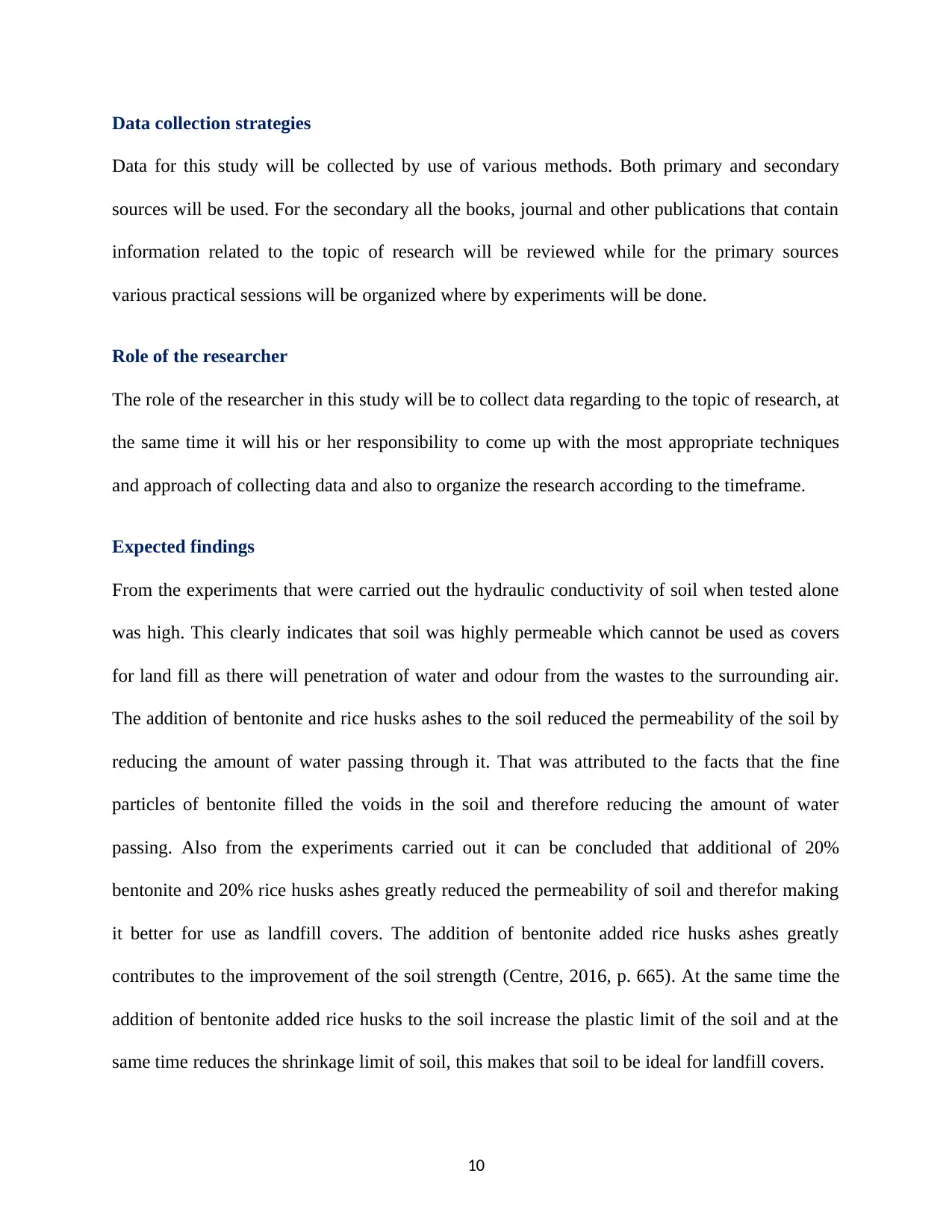
Data collection strategies
Data for this study will be collected by use of various methods. Both primary and secondary
sources will be used. For the secondary all the books, journal and other publications that contain
information related to the topic of research will be reviewed while for the primary sources
various practical sessions will be organized where by experiments will be done.
Role of the researcher
The role of the researcher in this study will be to collect data regarding to the topic of research, at
the same time it will his or her responsibility to come up with the most appropriate techniques
and approach of collecting data and also to organize the research according to the timeframe.
Expected findings
From the experiments that were carried out the hydraulic conductivity of soil when tested alone
was high. This clearly indicates that soil was highly permeable which cannot be used as covers
for land fill as there will penetration of water and odour from the wastes to the surrounding air.
The addition of bentonite and rice husks ashes to the soil reduced the permeability of the soil by
reducing the amount of water passing through it. That was attributed to the facts that the fine
particles of bentonite filled the voids in the soil and therefore reducing the amount of water
passing. Also from the experiments carried out it can be concluded that additional of 20%
bentonite and 20% rice husks ashes greatly reduced the permeability of soil and therefor making
it better for use as landfill covers. The addition of bentonite added rice husks ashes greatly
contributes to the improvement of the soil strength (Centre, 2016, p. 665). At the same time the
addition of bentonite added rice husks to the soil increase the plastic limit of the soil and at the
same time reduces the shrinkage limit of soil, this makes that soil to be ideal for landfill covers.
10
Data for this study will be collected by use of various methods. Both primary and secondary
sources will be used. For the secondary all the books, journal and other publications that contain
information related to the topic of research will be reviewed while for the primary sources
various practical sessions will be organized where by experiments will be done.
Role of the researcher
The role of the researcher in this study will be to collect data regarding to the topic of research, at
the same time it will his or her responsibility to come up with the most appropriate techniques
and approach of collecting data and also to organize the research according to the timeframe.
Expected findings
From the experiments that were carried out the hydraulic conductivity of soil when tested alone
was high. This clearly indicates that soil was highly permeable which cannot be used as covers
for land fill as there will penetration of water and odour from the wastes to the surrounding air.
The addition of bentonite and rice husks ashes to the soil reduced the permeability of the soil by
reducing the amount of water passing through it. That was attributed to the facts that the fine
particles of bentonite filled the voids in the soil and therefore reducing the amount of water
passing. Also from the experiments carried out it can be concluded that additional of 20%
bentonite and 20% rice husks ashes greatly reduced the permeability of soil and therefor making
it better for use as landfill covers. The addition of bentonite added rice husks ashes greatly
contributes to the improvement of the soil strength (Centre, 2016, p. 665). At the same time the
addition of bentonite added rice husks to the soil increase the plastic limit of the soil and at the
same time reduces the shrinkage limit of soil, this makes that soil to be ideal for landfill covers.
10
Secure Best Marks with AI Grader
Need help grading? Try our AI Grader for instant feedback on your assignments.
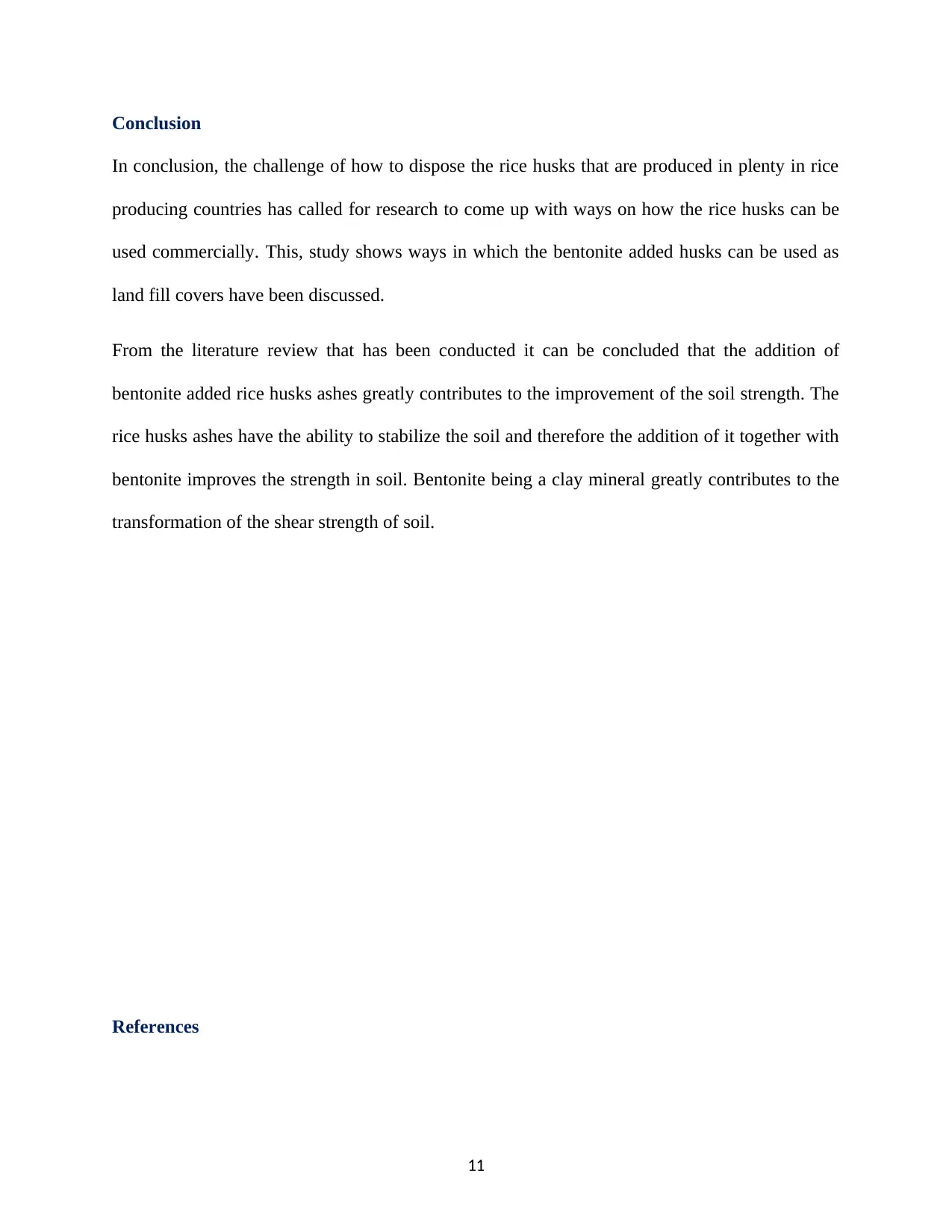
Conclusion
In conclusion, the challenge of how to dispose the rice husks that are produced in plenty in rice
producing countries has called for research to come up with ways on how the rice husks can be
used commercially. This, study shows ways in which the bentonite added husks can be used as
land fill covers have been discussed.
From the literature review that has been conducted it can be concluded that the addition of
bentonite added rice husks ashes greatly contributes to the improvement of the soil strength. The
rice husks ashes have the ability to stabilize the soil and therefore the addition of it together with
bentonite improves the strength in soil. Bentonite being a clay mineral greatly contributes to the
transformation of the shear strength of soil.
References
11
In conclusion, the challenge of how to dispose the rice husks that are produced in plenty in rice
producing countries has called for research to come up with ways on how the rice husks can be
used commercially. This, study shows ways in which the bentonite added husks can be used as
land fill covers have been discussed.
From the literature review that has been conducted it can be concluded that the addition of
bentonite added rice husks ashes greatly contributes to the improvement of the soil strength. The
rice husks ashes have the ability to stabilize the soil and therefore the addition of it together with
bentonite improves the strength in soil. Bentonite being a clay mineral greatly contributes to the
transformation of the shear strength of soil.
References
11
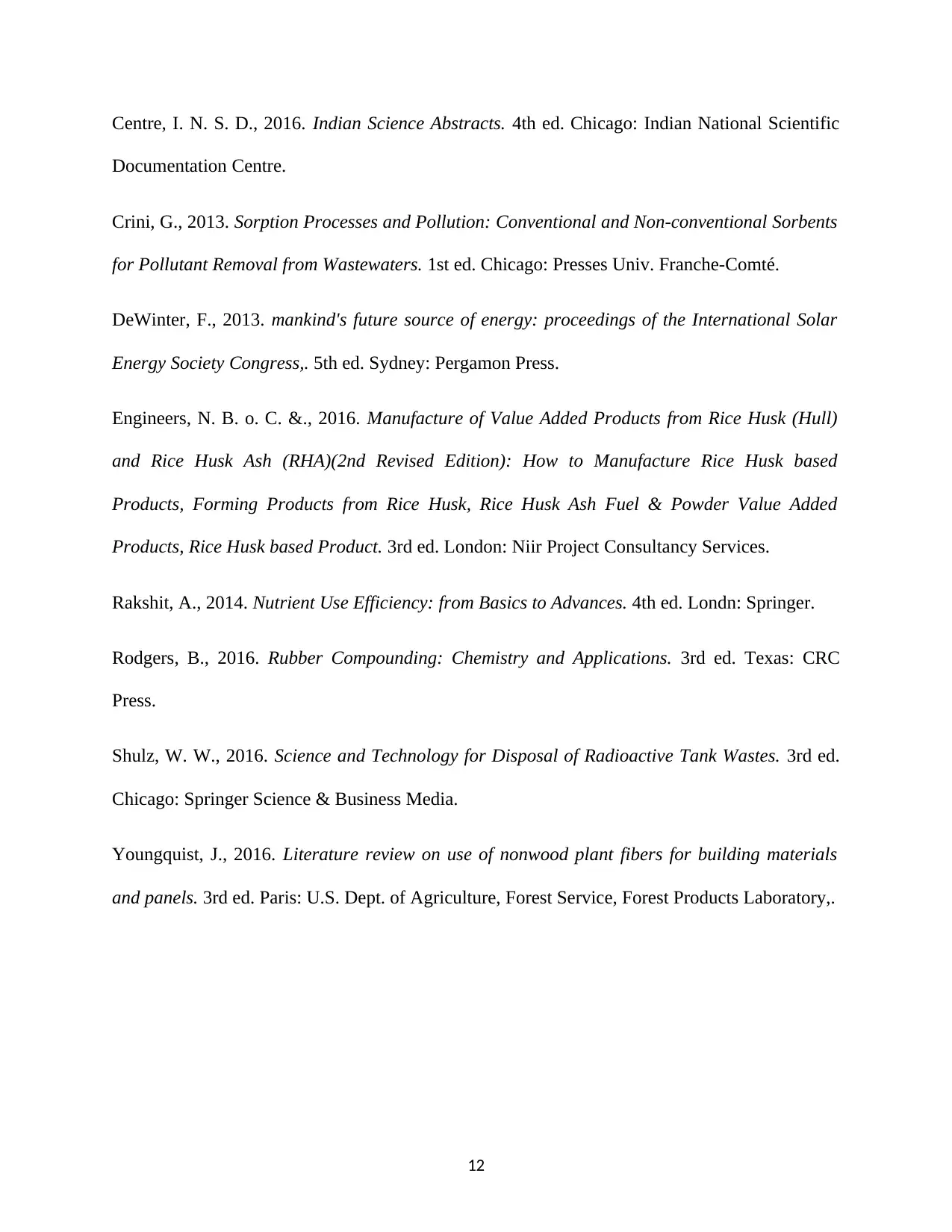
Centre, I. N. S. D., 2016. Indian Science Abstracts. 4th ed. Chicago: Indian National Scientific
Documentation Centre.
Crini, G., 2013. Sorption Processes and Pollution: Conventional and Non-conventional Sorbents
for Pollutant Removal from Wastewaters. 1st ed. Chicago: Presses Univ. Franche-Comté.
DeWinter, F., 2013. mankind's future source of energy: proceedings of the International Solar
Energy Society Congress,. 5th ed. Sydney: Pergamon Press.
Engineers, N. B. o. C. &., 2016. Manufacture of Value Added Products from Rice Husk (Hull)
and Rice Husk Ash (RHA)(2nd Revised Edition): How to Manufacture Rice Husk based
Products, Forming Products from Rice Husk, Rice Husk Ash Fuel & Powder Value Added
Products, Rice Husk based Product. 3rd ed. London: Niir Project Consultancy Services.
Rakshit, A., 2014. Nutrient Use Efficiency: from Basics to Advances. 4th ed. Londn: Springer.
Rodgers, B., 2016. Rubber Compounding: Chemistry and Applications. 3rd ed. Texas: CRC
Press.
Shulz, W. W., 2016. Science and Technology for Disposal of Radioactive Tank Wastes. 3rd ed.
Chicago: Springer Science & Business Media.
Youngquist, J., 2016. Literature review on use of nonwood plant fibers for building materials
and panels. 3rd ed. Paris: U.S. Dept. of Agriculture, Forest Service, Forest Products Laboratory,.
12
Documentation Centre.
Crini, G., 2013. Sorption Processes and Pollution: Conventional and Non-conventional Sorbents
for Pollutant Removal from Wastewaters. 1st ed. Chicago: Presses Univ. Franche-Comté.
DeWinter, F., 2013. mankind's future source of energy: proceedings of the International Solar
Energy Society Congress,. 5th ed. Sydney: Pergamon Press.
Engineers, N. B. o. C. &., 2016. Manufacture of Value Added Products from Rice Husk (Hull)
and Rice Husk Ash (RHA)(2nd Revised Edition): How to Manufacture Rice Husk based
Products, Forming Products from Rice Husk, Rice Husk Ash Fuel & Powder Value Added
Products, Rice Husk based Product. 3rd ed. London: Niir Project Consultancy Services.
Rakshit, A., 2014. Nutrient Use Efficiency: from Basics to Advances. 4th ed. Londn: Springer.
Rodgers, B., 2016. Rubber Compounding: Chemistry and Applications. 3rd ed. Texas: CRC
Press.
Shulz, W. W., 2016. Science and Technology for Disposal of Radioactive Tank Wastes. 3rd ed.
Chicago: Springer Science & Business Media.
Youngquist, J., 2016. Literature review on use of nonwood plant fibers for building materials
and panels. 3rd ed. Paris: U.S. Dept. of Agriculture, Forest Service, Forest Products Laboratory,.
12
1 out of 12
Your All-in-One AI-Powered Toolkit for Academic Success.
+13062052269
info@desklib.com
Available 24*7 on WhatsApp / Email
![[object Object]](/_next/static/media/star-bottom.7253800d.svg)
Unlock your academic potential
© 2024 | Zucol Services PVT LTD | All rights reserved.

